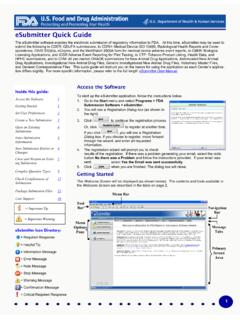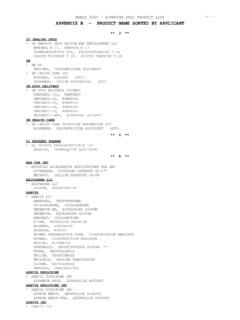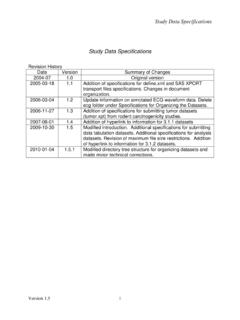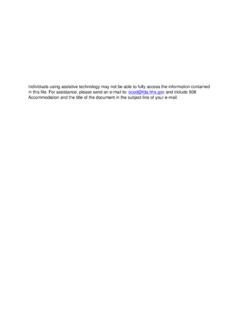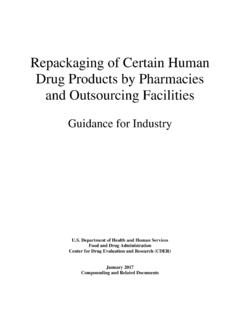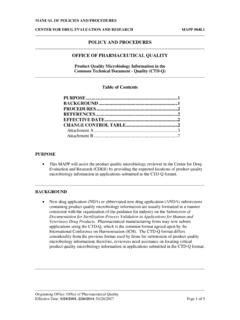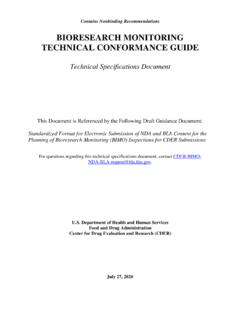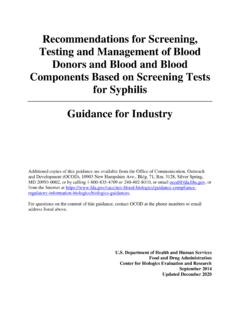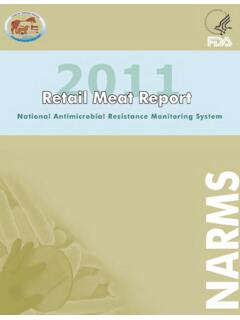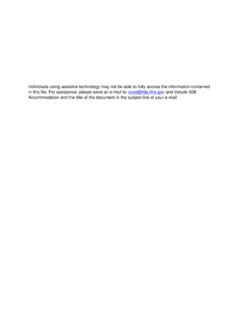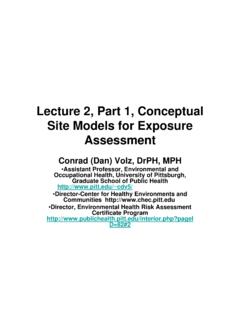Transcription of Guidance for Industry - Food and Drug Administration
1 Guidance for Industry Requalification Method for Reentry of Blood Donors Deferred because of Reactive Test Results for Antibody to Hepatitis B Core Antigen (Anti-HBc) Additional copies of this Guidance are available from the Office of Communication, Outreach and Development (OCOD) (HFM-40), 1401 Rockville Pike, Suite 200N, Rockville, MD 20852 1448, or by calling 1-800-835-4709 or 301-827-1800, or email or from the Internet at For questions on the content of this Guidance , contact OCOD at the phone numbers listed above. Department of Health and Human Services food and drug Administration Center for Biologics Evaluation and Research May 2010 Contains Nonbinding Recommendations Table of Contents I. 1 II. BACKGROUND .. 2 III. 5 IV. IMPLEMENTATION .. 6 V. 7 9 i Contains Nonbinding Recommendations Guidance for Industry Requalification Method for Reentry of Blood Donors Deferred because of Reactive Test Results for Antibody to Hepatitis B Core Antigen (Anti-HBc) This Guidance represents the food and drug Administration s (FDA s) current thinking on this topic.
2 It does not create or confer any rights for or on any person and does not operate to bind FDA or the public. You can use an alternative approach if the approach satisfies the requirements of the applicable statutes and regulations. If you want to discuss an alternative approach, contact the appropriate FDA staff. If you cannot identify the appropriate FDA staff, call the appropriate number listed on the title page of this Guidance . I. INTRODUCTION We, FDA, are issuing this Guidance to provide you, establishments that collect Whole Blood or blood components intended for transfusion, with recommendations for a requalification method or process for the reentry of deferred donors into the donor pool based on a determination that previous tests that were repeatedly reactive for antibodies to hepatitis B core antigen (anti-HBc) were falsely positive and that there is no evidence of infection with hepatitis B virus (HBV).
3 Currently, donors who are repeatedly reactive on more than one occasion for anti-HBc (samples from more than one collection from the same donor are repeatedly reactive for anti-HBc) must be indefinitely deferred in accordance with Title 21 Code of Federal Regulations, section (a) (21 CFR (a)). Although it may seem unlikely that two anti-HBc tests would be falsely positive, such situations have occurred with some frequency because of the relative non-specificity of these tests. The result is that many otherwise suitable donors are indefinitely deferred because of their anti-HBc test results, even though medical follow-up of such donors indicates that they are not infected with HBV. The availability of FDA-licensed hepatitis B virus nucleic acid tests (HBV NAT), which are particularly sensitive when single samples are tested, provides an additional, powerful method of determining whether a donor who has been deferred because of anti-HBc reactivity is truly infected with HBV.
4 Due to the availability of FDA-licensed HBV NAT and the improved specificity of anti-HBc assays, we are recommending in this Guidance a reentry algorithm for donors deferred due to falsely positive repeatedly reactive tests for anti-HBc. This Guidance finalizes the draft Guidance of the same title dated May 2008. FDA s Guidance documents, including this Guidance , do not establish legally enforceable responsibilities. Instead, guidances describe the FDA s current thinking on a topic and should be viewed only as recommendations, unless specific regulatory or statutory requirements are cited. The use of the word should in FDA s guidances means that something is suggested or recommended, but not required. 1 Contains Nonbinding Recommendations II. BACKGROUND A. Clinical Significance of Donor Screening for Hepatitis B Virus Infection HBV is an enveloped virus with a partially duplex circular deoxyribonucleic acid (DNA) genome of approximately 3,200 bases.
5 It is a major human pathogen that causes acute and chronic hepatitis, cirrhosis and hepatocellular carcinoma (Ref. 1). The mortality of acute HBV infection is about 1%. Most primary infections in adults are self-limited. The virus is cleared from the blood and liver, and individuals develop a lasting immunity. However, 2% to 6% of persons above the age of 5 years, and 30% to 90% of infected children under the age of 5 years (Ref. 2) develop chronic infections that generally are asymptomatic ( , a carrier state), but may not be benign. About 20% of chronically infected individuals develop cirrhosis, and chronically infected subjects have 100 times higher risk of developing hepatocellular carcinoma than non-carriers. In the United States, deaths from chronic HBV infection are estimated to range from 3,000 to 5,000 individuals per year (Ref. 2). Currently, HBV is transmitted by blood transfusions more frequently than hepatitis C virus or human immunodeficiency virus.
6 The residual risk of post-transfusion HBV infection from donations screened for hepatitis B surface antigen (HBsAg) and anti-HBc has been estimated as 1 in 205,000 (Ref. 3) to 1 in 269,000 (Ref. 4) per donated unit. The major cause of HBV transmission by blood is attributable to donations from asymptomatic donors with acute HBV infections who have not yet developed HBsAg or anti-HBc ( , donors in the seronegative window period) and, in some cases, from donors with chronic infections in which serological markers are not detected (occult hepatitis B). Seronegative blood donations from infected individuals can transmit hepatitis B. In such cases, lookback studies using polymerase chain reaction have shown that HBV DNA can be detected at low levels in the donor s blood (Ref. 5). HBsAg becomes detectable in blood 30 to 60 days after infection followed by the emergence of anti-HBc.
7 Viremia develops several weeks before HBsAg is detected, and can reach 109-1010 virions/ml in acute infections (Ref. 1). Upon clearance of the HBV infection by the immune response, the HBsAg disappears from the blood of individuals, while detectable anti-HBc and antibody to hepatitis B surface antigen (anti-HBs) usually persist indefinitely. However, there is evidence that anti-HBc can decrease and even disappear over a period of decades in resolved infections (Ref. 6). Nonetheless, in chronically infected individuals, tests for HBsAg and anti-HBc usually remain positive for life and lower viral titers can be detected in blood for a long period although they tend to decline over time. HBV NAT assays for detection of HBV DNA have been developed, and have been licensed for screening blood donations using a minipool sample format. These assays are also indicated for testing samples from individual donations, thus increasing test 2 Contains Nonbinding Recommendations sensitivity.
8 In a meeting of the Blood Products Advisory Committee (Committee or BPAC) on October 21, 2004 (Ref. 7), we requested scientific comment on a reentry algorithm for donors deferred for repeatedly reactive anti-HBc test results on more than one occasion. The algorithm was based on follow-up testing of the donor for HBsAg, anti-HBc, and HBV DNA by sensitive HBV NAT. Under this plan, HBV DNA testing using an FDA-licensed NAT would replace a previously considered recommendation for donor reentry that included antibody to hepatitis B surface antigen (anti-HBs) testing. We no longer propose additional testing for anti-HBs as part of donor reentry because extensive hepatitis B vaccination programs have been in place for a number of years, resulting in many individuals having anti-HBs from vaccination. As a result, anti-HBs now has questionable value as a marker of hepatitis B infection.
9 While the Committee did not take a formal vote on the algorithm, the Committee discussed this approach and did not express concerns about the adequacy of this plan as a reentry algorithm. Since the 2004 BPAC meeting referred to above, we have licensed qualitative tests for the direct detection of HBV DNA in human plasma from donors, including donors of Whole Blood and blood components, Source Plasma and other living donors, that have sensitivities of <2 International Units (IU)/mL (about 10 copies HBV DNA/mL) at 95% detection for HBV DNA when specific procedures are The availability of sensitive, FDA-licensed, HBV NAT assays provides an additional, powerful method of determining whether a donor, who has been deferred because of anti-HBc reactivity, is truly infected by HBV. Due to the availability of FDA-licensed HBV NAT assays and the improved specificity of anti-HBc assays, we are recommending a reentry algorithm for anti-HBc in this Guidance .
10 Empirical studies support utility of this algorithm (Ref. 8). B. Rationale and Procedure for the Requalification Method for Reentry Under 21 CFR (a), you must test each donation of human blood or blood component intended for use in preparing a product, including donations intended as a component of, or used to prepare, a medical device, for evidence of infection due to HBV, among other communicable disease agents. Testing for evidence of infection of HBV includes testing for the presence of HBsAg and anti-HBc. In addition, some blood establishments also test blood donations for HBV DNA by HBV NAT. Under 21 CFR (a), as a general matter, you must defer donors who test reactive2 with respect to the battery of screening tests required under 21 CFR However, donors who test repeatedly reactive for anti-HBc on only one occasion do not need to be 1 COBAS AmpliScreen HBV Test (Roche Molecular Systems, Inc.)
